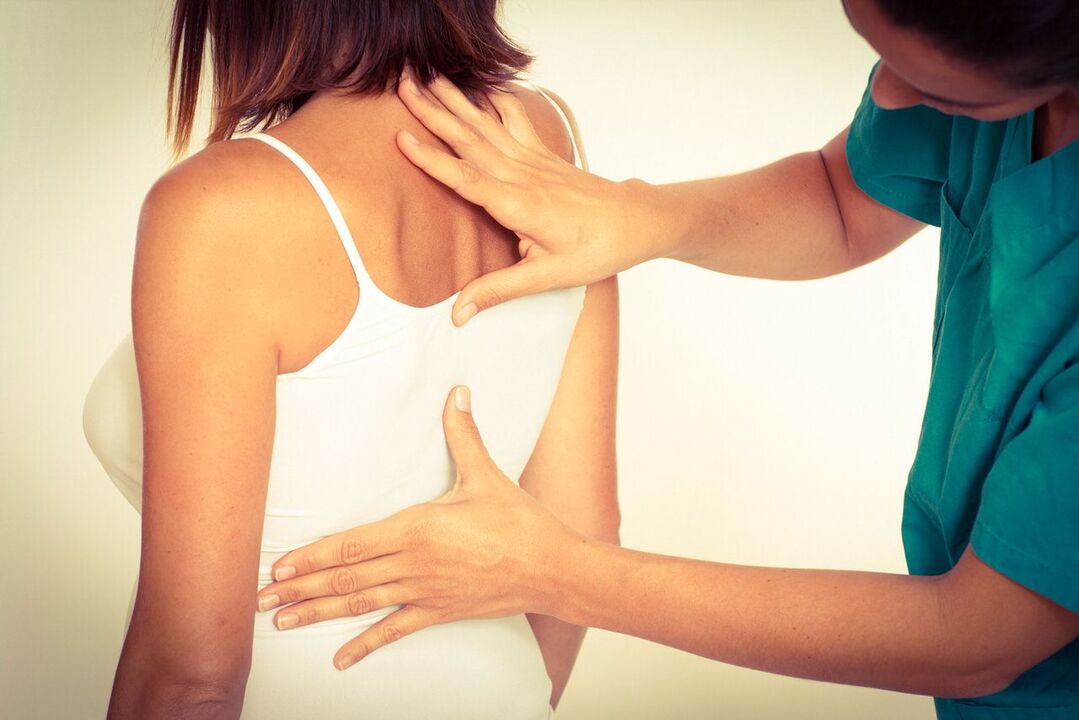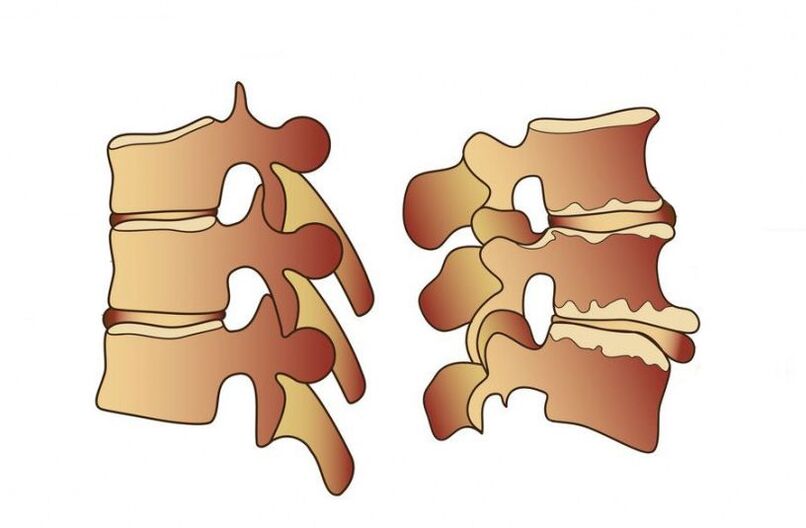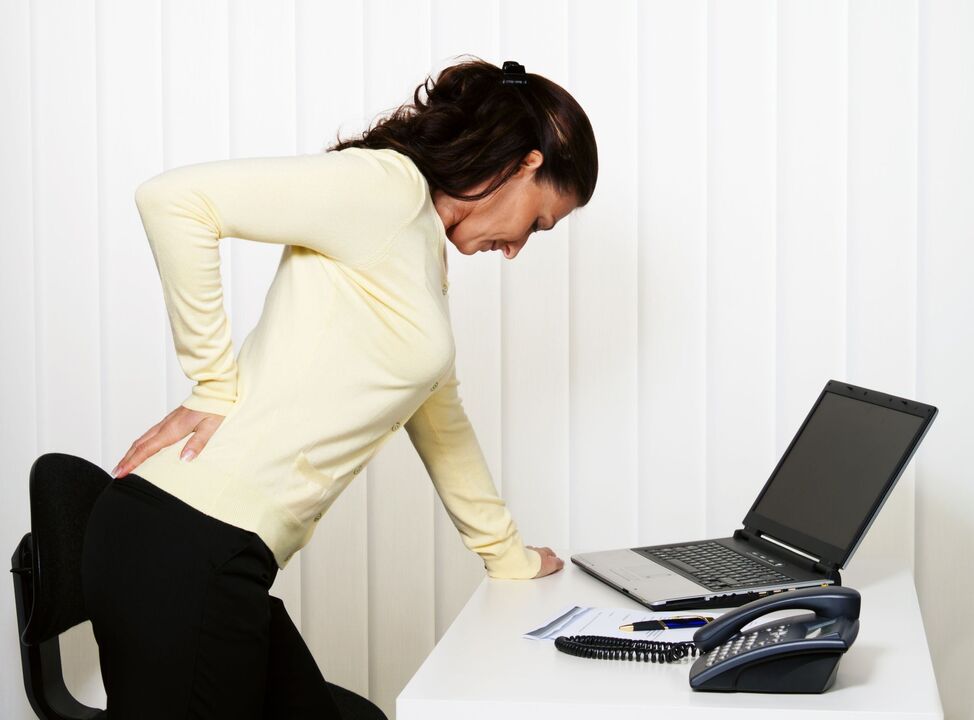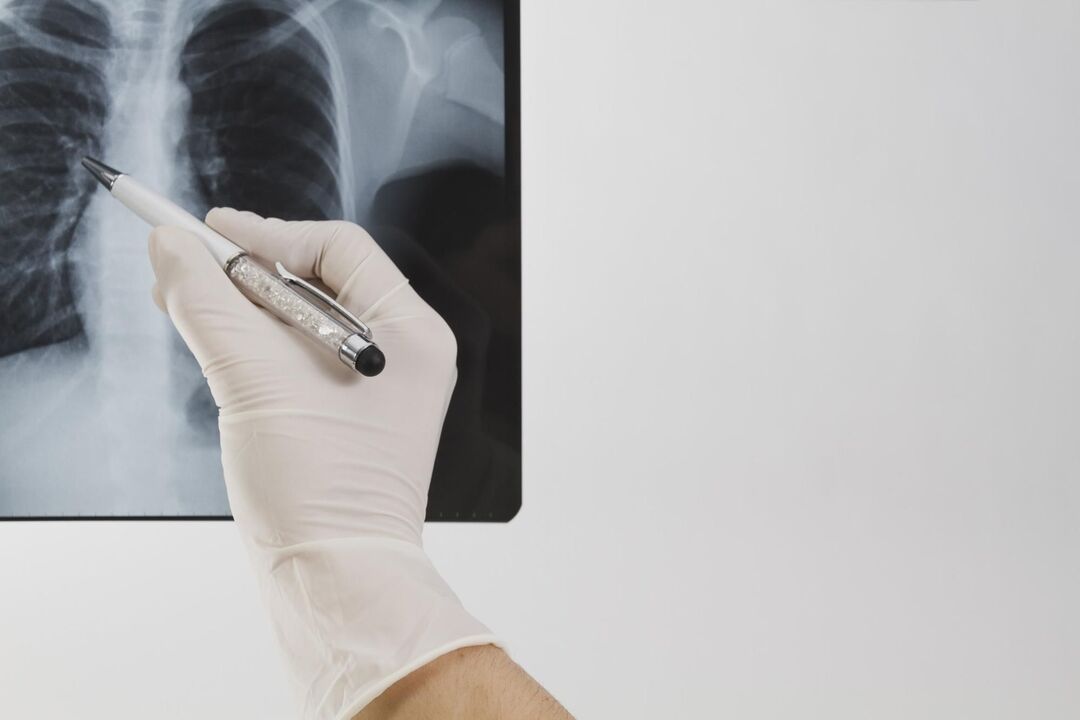
The most common degenerative-dystrophic disease of the spine is osteochondrosis. The peculiarity is that in the early stages it does not manifest itself in any way, so many patients turn to doctors when the process of tissue destruction has gone far. But even in this case, the diagnosis is not made immediately, but after a series of laboratory and instrumental examinations. It is very important to diagnose osteochondrosis correctly, because the earlier treatment is started, the greater the chance of preventing complications. For this reason you need to identify the symptoms of osteochondrosis in time and consult a doctor.
Causes and mechanisms of development
Osteochondrosis begins with a destructive process in the intervertebral disc. They gradually dry up and decrease in volume. This leads to the fact that the disk can no longer perform its functions correctly. They can collapse, and then a hernia develops. But often this condition leads to the development of osteochondrosis.
After all, the intervertebral disc protects the vertebrae from destruction, serves as a shock absorber during various movements and keeps the vertebrae in the correct position. As the volume decreases, the vertebrae become displaced. Instability of spinal segments leads to the formation of osteophytes - bony growths that hold the vertebrae at a distance. Otherwise, pinching of nerve roots and compression of blood vessels may occur. All these processes cause the presence of many different signs of osteochondrosis, which is why it is very difficult to diagnose it in time. But if you know why this pathology develops, people at risk can be more careful.
Osteochondrosis is usually caused by the following reasons:
- congenital disorders in the development of the spine or connective tissue defects;
- injury or constant load, heavy physical work;
- poor posture, flat feet, wearing uncomfortable shoes;
- staying in an uncomfortable position for a long time, a sedentary lifestyle;
- obesity, poor nutrition, overweight;
- exposure to chemicals, for example, having bad habits, taking certain medications;
- frequent stress;
- natural processes that occur during the aging of the body;
- the effects of continuous vibration on the spine.

Osteochondrosis develops after a decrease in the height of the intervertebral disc, after which the vertebra itself begins to collapse
Therefore, it is necessary to monitor your health carefully to consult a doctor at the first symptoms. This is especially important for athletes, loaders, drivers, gymnasts, women, who often worry about their loved ones and experience stress because of this.
symptoms
Signs of osteochondrosis depend on the stage of the disease, as well as on which part of the spine is affected by the degenerative process. Often, at first the patient does not feel back pain, only a little stiffness in the morning. In the process of destruction of the intervertebral disc due to displacement of the vertebrae, the nerve roots are pinched and pain occurs. Depending on the location of the disease, they can appear not only in the back area. Often the pain radiates to the shoulder blade, chest, arm or leg, and there may be a headache.
A characteristic of osteochondrosis in the early stages is that the pain increases with physical activity and subsides after rest. Even after adopting a comfortable body position, the patient feels better. The painful sensation worsens after hypothermia, stress, staying for a long time in a static position, for example, while working at the computer or while sleeping on an uncomfortable bed. Often, with osteochondrosis, stiffness in movement, muscle weakness, and constant fatigue are observed. The patient tries to take a comfortable position where he experiences less pain.

The main symptom of lumbar osteochondrosis is pain and stiffness in movement.
Symptoms of lumbar osteochondrosis
The most common location of the degenerative-dystrophic process is the lumbar spine. It can withstand the heaviest loads not only when moving, but also when a person sits for a long time in one position. Due to the sedentary lifestyle of modern people, the muscle corset here is weak, so any excessive load can lead to disc destruction or vertebral displacement.
In addition to general pain and stiffness, there are typical symptoms of osteochondrosis of the spine in the lumbar region. If the following signs make themselves felt from time to time, you need to make an appointment with a neurologist:
- lower limbs become numb;
- skin sensitivity is affected, paresis may develop;
- pain is felt in the pelvic organ, its function is disturbed;
- the patient cannot turn or bend, the pain is felt even when sitting.
Symptoms of cervical osteochondrosis
It is very important to know the symptoms experienced by patients with cervical osteochondrosis. After all, sometimes pain in the neck is not felt, and other symptoms are similar to vascular disorders that a person tries to treat with drugs. If the destruction process in the cervical spine is not stopped, this can cause interruption of blood supply to the brain and even complete paralysis of the body.
Therefore, it is very important to pay attention to the following signs in time:
- headaches that cannot be relieved by conventional analgesics;
- dizziness occurs when turning the head;
- pain can be felt in the shoulders, back of the head, arms;
- vision deteriorates, spots or colored spots appear in front of the eyes;
- there is hearing loss, tinnitus;
- tongue and fingers become numb;
- movement coordination is disturbed.

With cervical osteochondrosis, headaches and tinnitus are often observed
Symptoms of thoracic osteochondrosis
Signs of osteochondrosis in the thoracic region are easily confused with diseases of internal organs. And although the main symptom is back pain, it has its own characteristics. Patients describe this feeling as if the chest is squeezed by a hoop. The pain increases when inhaling and exhaling, so many attribute this sensation to heart pathology.
With thoracic osteochondrosis, the pain will increase with hypothermia, raising your hands, and also at night. You may experience numbness in the skin, goosebumps and cold feet. Disorders in the functioning of the digestive system often occur.
Diagnostics
To avoid complications of osteochondrosis, it is very important to consult a doctor as soon as the first signs appear. This is stiffness in movement and back pain after exercise. This pathology is treated by a vertebrologist or neurologist. An experienced doctor can make a preliminary diagnosis during the examination and conversation with the patient.
But some of the symptoms of this disease are very non-specific and resemble the manifestations of many other pathologies. Therefore, differential diagnosis is very important, which will help exclude diseases in which vascular and neurological symptoms also develop. This may be angina pectoris, hypertension, peptic ulcer, pyelonephritis. The main difference between osteochondrosis and them is that it has a chronic course and develops slowly, with periodic exacerbations, and the pain most often decreases with rest.
But without special diagnostics, it is still difficult to make a correct diagnosis. Often, instrumental examination methods are used for this: radiography, CT, MRI, ultrasound, myelography and others. Sometimes laboratory tests may also be necessary. They will help identify the presence of an inflammatory process and an increase in the concentration of calcium in the blood.

The most common diagnostic method in the early stages of the disease is radiography.
Radiography
In the early stages, X-ray diagnostics are needed to confirm the diagnosis. This is the main method of examination for osteochondrosis. It is the simplest and most accessible, and has the fewest side effects. After determining the location of the pain, photographs of this area of the spine are taken. They are usually carried out in two projections: direct and lateral.
If the diagnosis is made correctly, this will be shown by the following radiological signs: the distance between the vertebrae is reduced, intervertebral disc atrophy is observed, osteophytes are visible, there may be destruction of the vertebral tissue or changes in shape. from the spinal column.
Myelography
This is a more complex method, may have side effects, and is not suitable for everyone. After all, myelography is based on the injection of a special contrast liquid into the spinal canal. This can cause an allergic reaction or damage to the spinal cord. After this, the spine is x-rayed.
This method allows you to examine the spinal canal and determine where it is damaged by the degenerative process. In addition, myelography can determine the presence of intervertebral hernia at an early stage.

MRI is a more informative examination method, so it is used when a differential diagnosis is needed.
Tomography
Diagnosis of osteochondrosis using CT or MRI is carried out less often, because these methods are not yet available everywhere. Therefore, they are used in difficult cases, and also if necessary to distinguish osteochondrosis from other diseases. But with an MRI or CT scan, you can examine the spine and surrounding tissues in detail.
This diagnostic method allows you to see the condition of blood vessels, the presence of hernias, nerve root compression, and the shape of the intervertebral disc. They are necessary for the differential diagnosis of osteochondrosis from osteomyelitis, spinal cord tumors, spondylitis, ankylosing spondylitis, and syringomyelia.
Timely identification of symptoms of osteochondrosis and correct diagnosis will help to start treatment in time. This will prevent the development of complications, alleviate the patient's condition and reduce the number of exacerbations.

















































